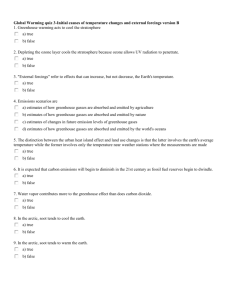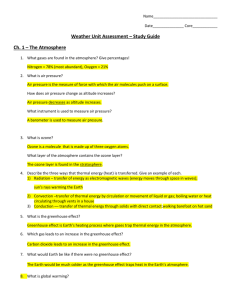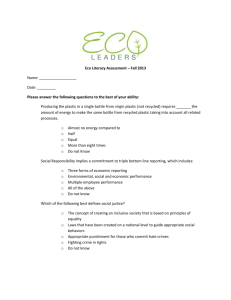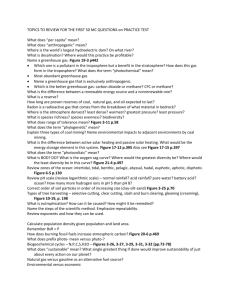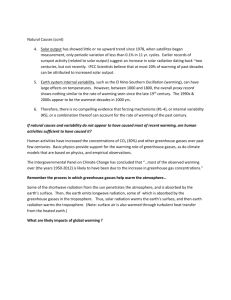Global_warming\Global warming quiz 3 C
advertisement
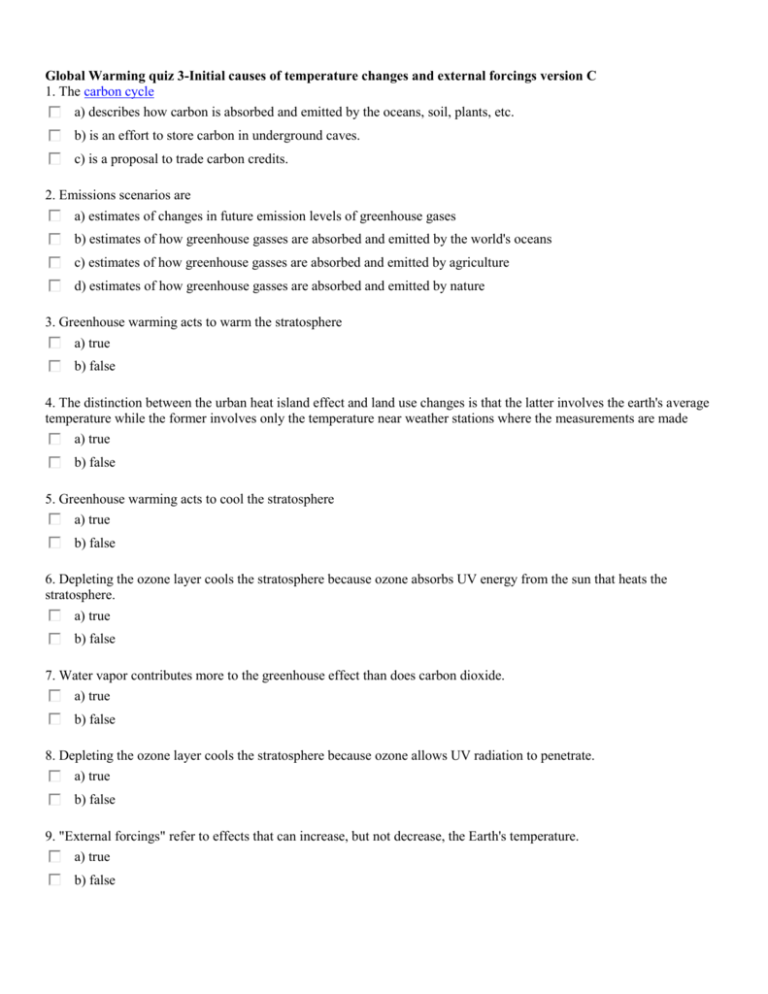
Global Warming quiz 3-Initial causes of temperature changes and external forcings version C 1. The carbon cycle a) describes how carbon is absorbed and emitted by the oceans, soil, plants, etc. b) is an effort to store carbon in underground caves. c) is a proposal to trade carbon credits. 2. Emissions scenarios are a) estimates of changes in future emission levels of greenhouse gases b) estimates of how greenhouse gasses are absorbed and emitted by the world's oceans c) estimates of how greenhouse gasses are absorbed and emitted by agriculture d) estimates of how greenhouse gasses are absorbed and emitted by nature 3. Greenhouse warming acts to warm the stratosphere a) true b) false 4. The distinction between the urban heat island effect and land use changes is that the latter involves the earth's average temperature while the former involves only the temperature near weather stations where the measurements are made a) true b) false 5. Greenhouse warming acts to cool the stratosphere a) true b) false 6. Depleting the ozone layer cools the stratosphere because ozone absorbs UV energy from the sun that heats the stratosphere. a) true b) false 7. Water vapor contributes more to the greenhouse effect than does carbon dioxide. a) true b) false 8. Depleting the ozone layer cools the stratosphere because ozone allows UV radiation to penetrate. a) true b) false 9. "External forcings" refer to effects that can increase, but not decrease, the Earth's temperature. a) true b) false 10. In the arctic, soot tends to cool the earth. a) true b) false 11. Global dimming, caused by air-born particulates produced by volcanoes and human made pollutants a) is more related to the ozone problem than to global warming b) exerts a cooling effect by increasing the reflection of incoming sunlight c) exerts a heating effect by absorbing infra-red radiation from earth's surface 12. "External forcings" refer to effects that can either increase or decrease, the Earth's temperature. a) true b) false 13. The "Greenhouse effect schematic" in the section on "Temperature changes..." indicates that most of the energy from the Sun is absorbed by the earth's atmosphere. a) true b) false 14. Carbon dioxide contributes more to the greenhouse effect than does water vapor. a) true b) false 15. Soot tends to warm the earth when it accumulates in atmospheric brown clouds. a) true b) false 16. In the arctic, soot tends to warm the earth. a) true b) false 17. The climate change community is divided between those who believe the goal should be to eliminate the earth's greenhouse effect altogether, and those who argue that we should attempt to minimize earth's greenhouse effect. a) true b) false 18. Soot tends to cool the earth when it accumulates in atmospheric brown clouds. a) true b) false 19. The Keeling curve shows that carbon dioxide concentrations a) show a steady rise in CO2 levels, at constant slope, and regular and predictable annual fluctuations b) show a steady rise in CO2 levels, at constant slope, and irregular fluctuations due associated with El Ninos and La Ninas. c) show a steady rise in CO2 levels, with increasing slope, and regular and predictable annual fluctuations 20. It is expected that carbon emissions will begin to diminish in the 21st century as fossil fuel reserves begin to dwindle. a) true b) false 21. Approximately what percent of global warming can be attributed to a long-term trend (since 1978) in the sun's energy? a) 0% b) 50% c) 10% d) 30% 22. Which external force plays the smallest role in current efforts to model global warming? a) greenhouse gasses b) solar luminosity (i.e. variations in energy from the sun) c) volcanic eruptions d) orbital cycles 23. The "Greenhouse effect schematic" in the section on "Temperature changes..." indicates that most of the energy from the Sun is absorbed at the earth's surface. a) true b) false
